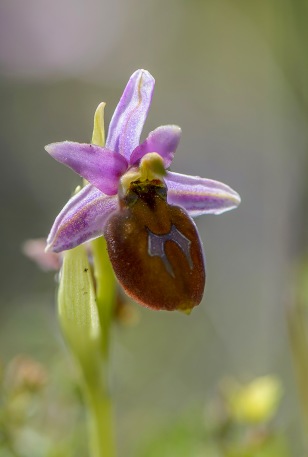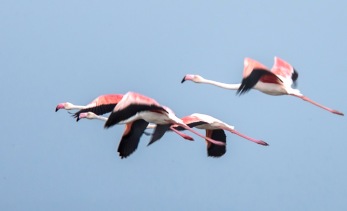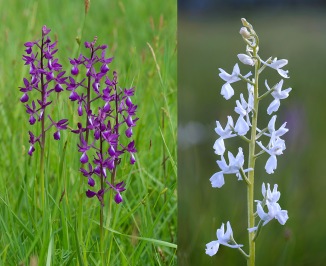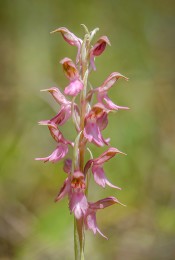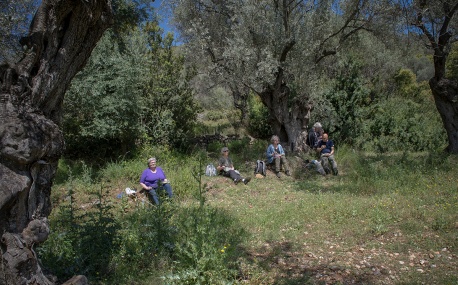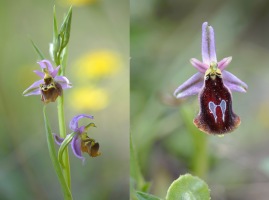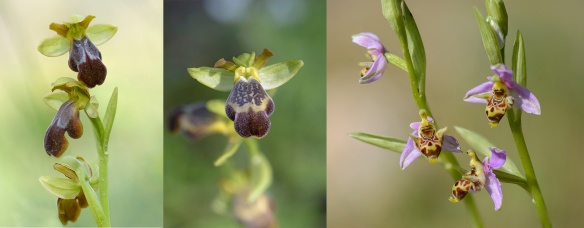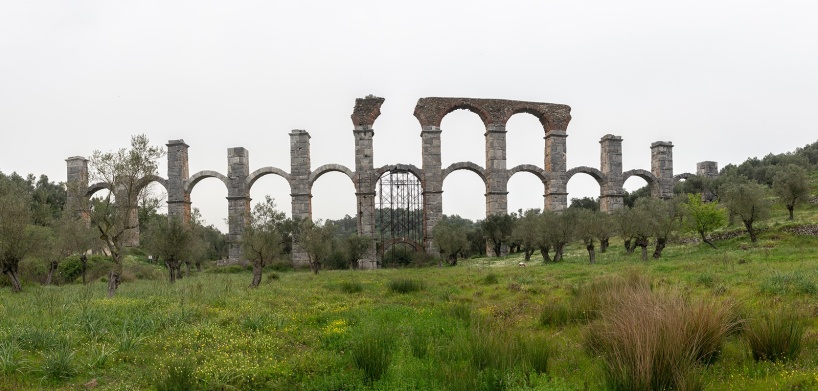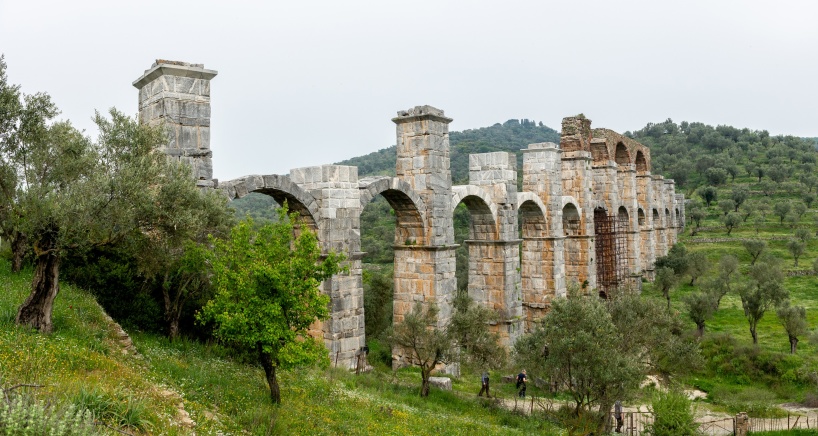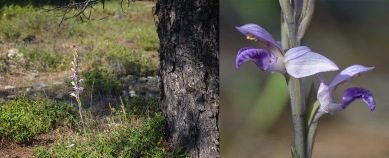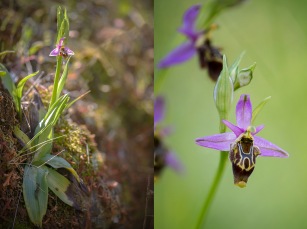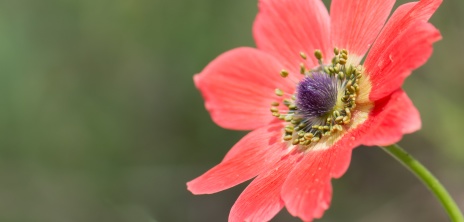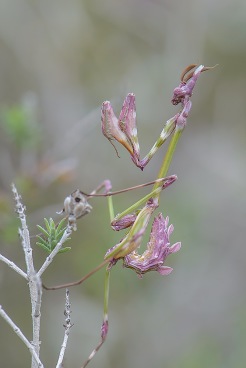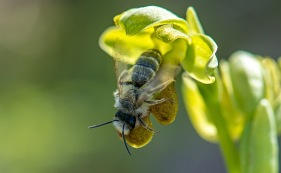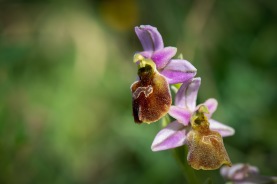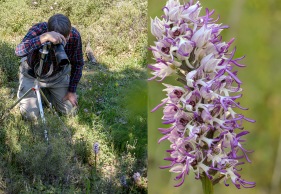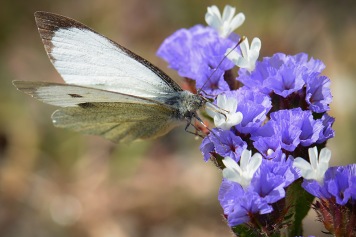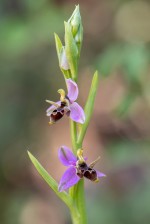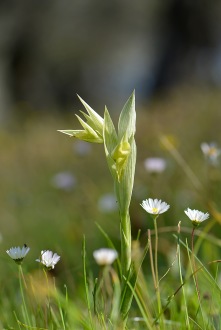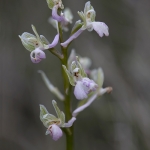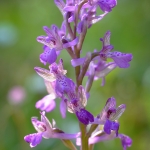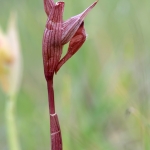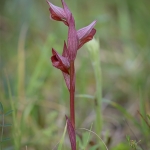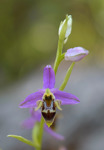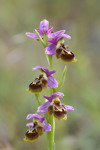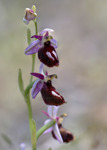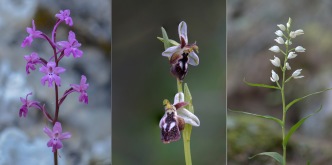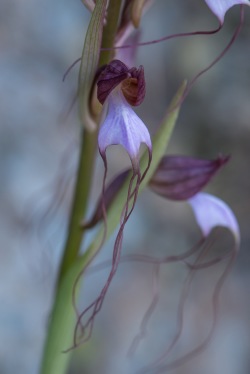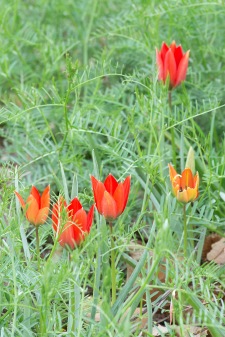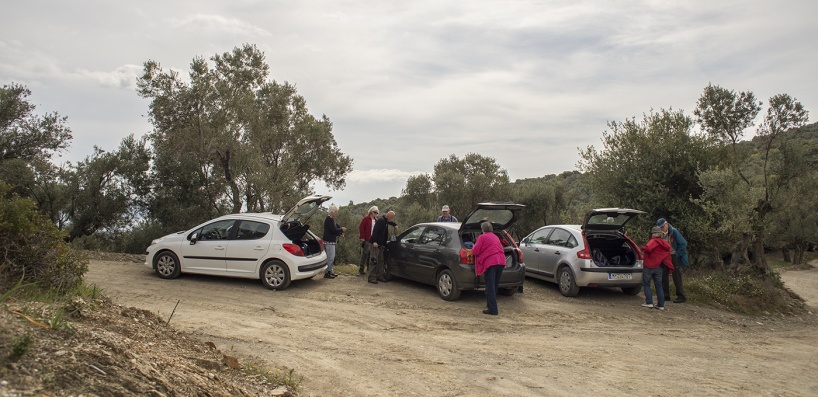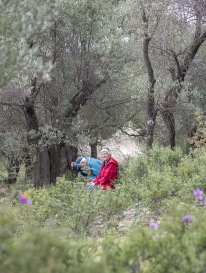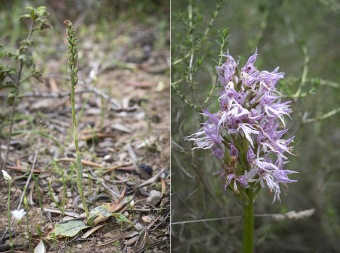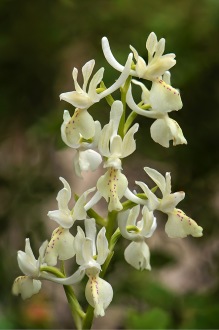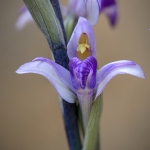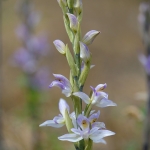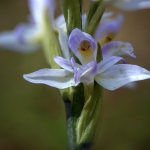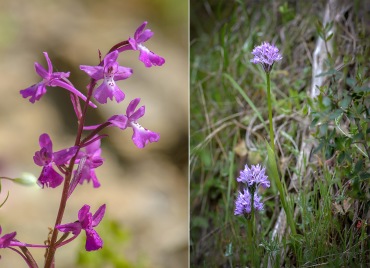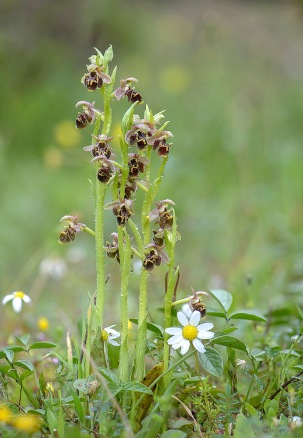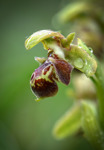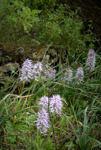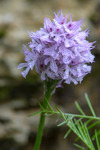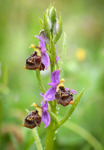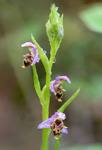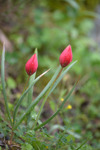Home | Orchid sites | Galleries | Comments | Search
No coordinates is given in site descriptions below. For precise coordinates, please contact me using the contact form.
All picture vill give you a bigger picture when clicking in it.
Lesvos 2014 - with comments from 2015/2018
Now another spring week at the Mediterranean has been completed. According the autumn / winter's plan, Lesvos should be visited. Lesvos (Lesbos), one of the Greece's Aegean islands, just a few kilometers from the Turkish coast, has become a popular target for orchid-interested, as many new species have been recorded. Today there are over 90 species found on the island. For a long time, the island has been known among birdwatchers as a very good place to watch birds during spring and autumn migration, but now also for orchid lovers.
This year's group finally became 16 members since some, due to illness, had to cancel their participation in a late stage. Departure was done partly from Stockholm, partly from Gothenburg and finally some joined the journey at our stopover in Copenhagen. It felt like a miss on the outward journey that we had to stay about 8 hours at the airport in Athens before our plane departure to Mytilini at Lesvos. Here, however, we had made a change from the usual routine of picking up cars and then driving to the hotel. With help from the hotel owner, we had hired a transfer bus that took us to Skala Kallonis about one hour's drive from the airport. An appreciated option as it was almost midnight before we reached the hotel. Also appreciated was the buffet that was available when we arrived, most of us were quite hungry at that time.
This year's base was the small town of Skala Kallonis, located approximately in the middle of the island, at the far end of the great Kalloni Gulf. We stayed here during the week, at the family-run hotel Malemi Hotel & Spa. A really good choice it proved to be, because at the hotel we had done this year's second change from the routines; we had chosen full pension, that is to say breakfast, lunch and dinner.
The lunch, which we usually eat outdoors on our excursions, consisted of a well-stocked lunch box, which was ready to bring after breakfast, and contained various cold dishes during the week plus some fruit, bread and a bottle of water. An excellent alternative to that each and one have to find their own solutions.
The weather, which is important for our excursions, showed up to be really nice even though it was a heavy rainfall at our arrival. But as George, our hotel host said, this rain was a gift for the island. The autumn, winter and also this spring had been very dry and therefor all rain was needed. We managed almost the whole week without rain, only at the last day’s lunchtime there once again was some heavy rainfall. But even this time we got lucky. The sites we searched during the morning had not given many orchids but here at the last stop for the day we had found maybe the best site for the whole journey. The rain stopped just as we entered the site and didn’t start again before we, one and a half hour later, were in the cars again for our return to the hotel.
Dry and warm spring
The dry and warm climate that lasted from last year had also affected the orchids. We could see that the spring had been early and at most sites there were few flowering plants. Several of the species we found was only seen as single specimen. Some species was already faded or started to fade, for example Orchis italica that use to be numerous at this time. This early spring had also made that, usually late flowering species, could be found flowering. We could this time find Anacamptis sancta, a species that we haven’t found at previous journeys because of late flowering time. Here at Lesvos it seems to be one of the most common orchids. It could be found at almost all sites we visited, but mostly only with buds. Neotinea lactea and Neotinea maculata was only found with seed pods. Following species were at most sites gone: Anacamptis collina, Ophrys speculum, Ophrys villosa and Dactylorhiza romana.
A species that we only found with buds was the magnificent Himantoglossum comperianum. Another species we hoped to see was Lesvos own orchid, Ophrys lesbis which has got its name from the island but isn’t endemic for Lesvos since it is found at several of the Aegean islands and even at the Turkish mainland. We managed to find this but it was in the end of its flowering period and most of the plants we saw had faded.
In the end of our week we had found 50 species, some color variants and even some hybrid, a result that was above our expectations.
Lesvos own orchid, Ophrys lesbis
2015 10-17 May
This journey was mainly for birding but there was also time for searching for orchids. The sites visited for orchids where almost the same as 2014. The later time of year make it possible to find Himantoglossum comperianum and Platanthera holmboei flowering.
2018 9-18 April
This years journey was very much like 2014 from a orchid point of view. At lower levels many orchids already had withered.
Below is a summary of our excursions at Lesvos and what we found.
Excursions OVERVIEW MAP ROUTE 1 -6
For different reasons, not all sites at our pre-planned routes were visited.
Day 1. Saturday 12 April. Route 3: East of the Gulf of Geras
There had been very little rain during previous autumn and winter and as result a warm winter and an early spring this year. An advice we got was that if we were going to the area east of the Gulf of Geras we should do that as early as possible. This area is known to be the area where orchids first start their flowering. Our Route 3 was the one that covered this area and even the fact that this went on just above sea level made us choose this route for our first excursion.
When in air the red wings are more prominent
From our hotel, via Kalloni, we followed the main road to Mytilene toward southeast to the Golf of Geras where we left this road and followed the east side of the golf further south. But before we came that far we had made a stop at the salt pans just east of Kalloni. Here, in the morning light, we would like to study the flamingos that here could be seen in great numbers. Here in the shallow waters there were several other waders too. In a close range we could study Pied Avocet and Black-winged Stilt, who became an absolute favorite with their thin, disproportionately long legs
Black Winged Stilt becom a favorite among most group members
Site 1: Wetland area at the road cross to Plomari
About 31,5 km from our hotel there is a road to the right, signposted Plomari. Just south of the road cross, next to the road, there is a quit big wetland area. This was our first site (next the stop for flamingos). The area had a huge amount of Anacamptis laxiflora, including an albino variant. A really nice start for this our first day.
Orchids found:
Anacamptis laxiflora
Anacamptis laxiflora, alba-form
Anacamptis palustris, only leaf
Anacamptis laxiflora x palustris
May 2015: This area was covered by A. palustris (probabely both palustris and elegans)
Anacamptis laxiflora
Site 2: Pirgi – Loutra road 1
The road further south along the coast doesn’t offer many places suitable for parking our number of cars. But at site 2 there was a path up to the terraced olive grove and here we managed to park the cars roadsides. The area first looked like it was completely dried up but after some searching we found one plant of flowering Anacamptis sancta. Usually this wouldn’t be flowering until the end of April but now we get help from an early spring.
Orchids found:
Anacamptis pyramidalis
Anacamptis pyramidalis, vit form
Anacamptis sancta
Ophrys spruneri
Serapias bergonii Anacamptis sancta
Site 3: Pirgi – Loutra road 2
Just some km further along the road we reached site 3. Here it was easier for parking near an olive grove. The shade under the olive tree was a great place to enjoy the lunch basket from the hotel. The area with the open olive grove was also interesting from an orchid point of view and several species were noted.
Idyllic olive grove, a nice place for lunch
Orchids found:
Anacamptis pyramidalis
Anacamptis sancta
Ophrys homeri
Ophrys ferrum-equinum ssp. labiosa
Ophrys sicula
Ophrys homeri and Ophrys ferrum-equinum ssp. labiosa
Back to page top
Site 5 + 5b. Loutra Headland
Since we didn’t find suitable parking at site 4 we continued to site 5. So we drove down to the small town Skala Loutron just south of the peninsula, Loutra Headland, which points out into the Golf of Geras. A narrow road follows the coastline around the peninsula and we drove this for about two kilometers. From beginning the slopes to the right was too steep for walking but further on this changed and we started to search for orchids. There was lot of orchids. Among others some Ophrys fusca species that was complete faded and impossible to identify.
The Gulf of Geras norrows down to a narrow strait at the entrance. A quick trip down to the beach showed an alluring blue sea.
5B: We followed the road further about 600 m. The slopes were here mostly covered by bushes but many orchids could be found among those. We could see that there had been a lot of Ophrys speculum here some week or two ago, but now they were all faded.
Orchids found:
Anacamptis pyramidalis
Anacamptis sancta
Ophrys attaviria
Ophrys ferrum- equinum
Ophrys leucadica
Ophrys mammosa
Ophrys oesrtifera
Ophrys parosica
Ophrys pelinaea
Ophrys sicula
Ophrys sitiaca
Ophrys speculum
Ophrys homeri Some of the species found here, from left:Ophrys pelinaea, Ophrys sitiaca and Ophrys oestrifera
Ophrys umbilicata
Orchis italica
Serapias politisii
Above site was the last site for the day. Since the day began to be late we decided to skip site 6 at our preplanned route and instead return back to the hotel. We returned same way as we had come.
2018
At this trip we added a visit to Lesvos biggest Roman Aqueduct at Moria. This is a “must see” at Lesbos.
Day 2. Sunday 13 April. Route 2: Skala Kalloni - Lambou Mili - Pigi
For this our second day we choose Route 2. This went eastward and started as yesterday route until we reached the little town Lambou Mili. Here we turned left and headed northeast toward Pigi. The route ended some km north of this town. We was warned that there was big roadwork going on between Lambou Mili and Pigi and therefor maybe difficult to drive this part of the road. Furthermore we was told that maybe all vegetation along the road would be covered by dust from the roadwork. But since this was a holyday there was no roadwork going on and the rain that earlier come had cleaned all flowers. This stretch of the road was also the one that had the orchid richest sites and we didn’t want to miss them.
Site 0. Limodorum-site
About 9 km before Lambou Mili we did an unplanned stop since we get sight of some big Limodorum abortivum roadside. An old part of the road to the left was good for parking meanwhile we explored the wooded area to the right which proved to contain lot of Limodorum.
Species found:
Limodorum abortivum
Ophrys leucadica
Serapias bergonii High growing Limodorum, easily seen from the road
2018
Site 1: Main road at a concrete water cistern
This site was not visited by us this year, but 2018 we searched this with nice result.
After about 16 km is it possible to stop at the left side of the road. In the slope at the opposite side there is a grey water cistern. The open forest behind this is site 1.
Orchids found:
Anacamptis coriphora subsp. fragrans (bud)
Anacamptis morio subsp. caucasica
Anacamptis sancta (bud)
Serapias cordigera Serapias bergonii
Serapias cordigera
Serapias parviflora
Serapias politisii
Site 3. Track to Roman aqueduct.
We didn’t stop at sites 1 and 2 according our pre-planned route, so site 3 was our next stop. Just before you passing Lambou Mili there is a green building (fabric?) and just before this there is a small road (gravelled) to the right. Here is space for parking. A track went down through the slopes to the Roman aqueduct several hundred meters further. We were told that there should be lot of orchids and there was.
Site 3b. Road to Pigi 1
The site is the area to the right of the road immediately after we turn left towards Pigi and about 400 m along the road.
Note: 2018, the use of this area has changed and almost no orchids were found.
Orchids found (2014):
Anacamptis morio ssp.caucasica
Ophrys calocaerina
Ophrys homeri
Ophrys pelianea
Ophrys leucadica
Ophrys masticorum
Ophrys minutula
Ophrys oestrifera
Serapias bergonii
Serapias vomeracea
Site 4. Road to Pigi 2
About 1.7 km from the Lambou Mili-road there is a big building to the left. The slopes with olive at the opposite side were very species rich.
Orchids found:
Anacamptis morio ssp. caucasica
Anacamptis sancta
Ophrys attica
Ophrys masticorum
Ophrys minutula
Ophrys oestrifera
Ophrys sicula
Ophrys umbilicata Orchis italica Anemone coronaria can be found with many different colors. Here an unusual red one.
Serapias bergonii
Serapias orientalis ssp.carica
Following spcies were added 2018
Ophrys calocaerina
Ophrys ceto
Ophrys dodecanensis
Ophrys fusca sp.
Ophrys homeri
Ophrys bilunulata subsp. punctulata
Ophrys pelinaea
Serapias vomeracea
Site 5. Road to Pigi 3
Further about 1,5 km site 5 was the slopes to the right. Old olive grove partly overgrown by bushes. Many species but few of each. A special finding was an Empusa pennata that get the cameras to go.
Orchids found:
Anacamptis morio ssp. caucasica
Anacamptis sancta
Ophrys homeri
Ophrys ferrum-equinum
Ophrys iricolor
Ophrys leucadica
Ophrys masticorum
Ophrys minutula
Ophrys pelianea
Ophrys sicula
Ophrys speculum
Orchis italica
Serapias bergonii
Site 6. Road to Loutropoli Termis
From site 5 we continued toward Pigi and then passed the town. After about some km we reached site 6. The area looked much drier than the previous sites and most of the orchids we saw was withered.
Orchids found:
Ophrys minutula
Ophrys oestrifera
Ophrys sicula
Ophrys speculum
Day 3. Monday 14 April. Route 1: Skala Kallonis - Sigri
This part of the island was unlike what we seen at the eastern part, almost treeless and barren.
For this our third day we had two main goals, to see the famous petrified forest and to find Lesvos own Ophrys, Ophrys lesbis. The route contained quite a lot of sites and we were unsure about how many we would be able to visit, if we also wanted to see the petrified forest. This is located furthest west near the town Sigri. We therefore chose to start with the "forest" and then take the orchid sites in reverse order.
Unfortunately, we found that the "forest", which is an open-air museum, with high fences, was closed on Mondays. We therefor just had to turn back to the main road and the orchid sites in Route 1. It can be noted that the roads leading to the sites after Andissa, were in a very bad condition and cannot be recommended for regular cars other than in dry weather.
Site 2. Hairpin curve just after Andissa
Today's first stop, to search for orchids, became our map's site 2. The hairpin curve just north of Andissa was one of sites where O. lesbis was noted from. We also had, before departure, been given precise tips on where it would be but it was also said that it was possible that it already had faded, and so it was too, but we managed to find one that was pretty fresh, at least as we could get a decent photo.
Orchids found:
Anacamptis collina,almost faded
Anacamptis sancta Bee pollinating Ophrys pelinaea
Ophrys attica Photo from 2018 Ophrys bucephala
Ophrys lesbis
Site 3. Road Andissa – Lapsarna 1
Just after Andissa, we left the road to the right toward Lapsarna. After about 700 m we turned off on a small road to the right. Here was site 3. However, the area seemed very dry and there was not much orchids to see. At least we found, in the shadow of some bushes, some fine Orchis simia.
Orchids found:
Orchis simia
Ophrys simia
Site 1. Andissa – Gavathas
We returned to the Lapsarna road, and should now visit the sites in reverse order, 6, 5, 4 and finally site 1. The landscape seemed completely dried up and there were almost no chances to stop outsides cultivated / grazed fields. We therefore passed both site 6 and 5 without stopping.
At site 4 we took our lunch sitting at a nice little church, but there were no orchids here either. The whole area was covered by Cistus. Probably was the area burned some years ago.
Finally we reached our map’s site 1. This was at a sharp left hand curve, at the Andissa-Gavathas road, just some km before we were back on the main road to Andissa (coming from east, as we did in the morning, the road cross is about 2 km before you reach Andissa). Here we found Ophrys lesbis again but also those ones were almost withered.
2018
This year we was told about another site along the Gavathas road that we now visited. Some km further toward Gavathas (4 km from the main Antissa-road) after turned left toward Liota, there is a track going into the olive grove to the left (NB: Just a small gate in the fence). Here we parked the cars and walked further some hundred meters along the track. It turned out as an orchid rich area.
Orchids found:
Ophrys attaviria
Ophrys calocaerina
Opheys cornutula
Ophrys minutula
Ophrys pelinaea
Ophrys sitiaca Ophrys cornutula
Day 4. Tuesday 15 April. Route 5: Plati - Sanatorio
It was now Tuesday and for this our fourth day we chose Route 5 which would take us to slightly higher lying areas than earlier. Plati is a hillock just west of Geras golf. From there we would go westward to the eastern slopes of Mount Olympos, the highest mountain of the island.
Site 1. Plati 1
From the main road to Mytilini, at Lambou Mili, we turned right toward Asomatos. Here we drove through a changing and beautiful landscape. Site 1 was a nice olive grove with an incredible amount of herbs at the ground, including a lot of Anemone coronaria with the most varied colors, but also many orchids. This site was a highlight of this journey, walking around in the semi-shady grove with its old stone-walls and olive trees.
Orchids found:
Anacamptis morio ssp. caucasica
Neotinea tridentata
Orchis italica
Serapias bergonii
Serapias orientalis ssp. carica
Serapias orientalis ssp. carica var. monantha
Serapias orientalis ssp. carica, chlorantha-form
Serapias vomeracea
Chlorantha-form of Serapias orientalis ssp. carica
Site 1b. Plati 2. At the top
This site was the road further up to the top of the hill (steep and narrow). At the top there were mostly stones but between all those we found lot of orchids.
Orchids found:
Anacamptis morio ssp. morio
Anacamptis morio ssp. caucasica
Anacamptis sancta
Neotinea tridentata
Ophrys dodecanensis
Ophrys ferrum-equinum ssp. ferrum-equinum
Ophrys ferrum-equinum ssp. labiosa
Ophrys fusca sp.
Ophrys homeri
OPhrys masticorum
Ophrys minutula
Ophrys oestrifera
Ophrys orphanidea
Ophrys sicula
Ophrys villosa,almost withered
Orchis italica
Orchis quadripunctata
Ophrys ferrum-equinum ssp. labiosa
among all stones
Orchids found at the Plati sites
Site 3. Sanatorio
Down from Plati again we chose to skip the 2nd site and instead drive directly to site 3. Since we had been advised to not to try driving the shortest route, via winding small roads, we decided to drive back to the main road and then follow this to Agiasos, which we passed at the outskirts of. Site 3 was the area along the track to the right. From this area there was Himantoglossum comperianum noted, and we also found it but unfortunately we were here too early.
Site 4. South of Sanatorio
South of Sanatorio there is some hairpin curves, just after the last one behind the fence there are some H. comperianum, but at this time only buds. Not many other orchids.
Orchids found:
Cephalanthera longifolia
Himantoglossum comperianum (buds)
Ophrys sicula
2015-05-13: H. comperianum was flowering nicely at this site.
This became the last stop for the day before we returned home to the hotel the same way we arrived during the day.
Himantoglossum comperianum.
photo from May 2015
2018
Another site in this area was visited this year (as well as 2015). Further along the road from site 4 above you have a goat-farm to the right. About 200 m beyond this, the road does a rather sharp right hand curve. Here you will find a track to the left. Some couple of 100 meters along this you reach the site. It is a meadow-like area with some trees. Different Tulips and Frittilaria can be found together with lot of orchids. This is one of few sites in Europe where you can find Platanthera holmboei. At our visit 2018 this species was found only with buds but 2015-05-13 they were flowering nicely.
Orchids found:
Anacamptis morio subsp. caucasica
Cephalanthera longifolia
Epipactis sp. (bud)
Limodorum abortivum
Neotinea tridentata
Orchis provincialis
Platanthera holmboei
Tulips, probabely Tulipa aegenensis och Tulipa praecox
Day 5. Wednesday 16 April. Route 4: Eastern Lesvos
The cars are an important part of this kind of journey. Cars with ample space for four are preferred.
Route 4, which was chosen for this day from our pre-planned routes, went once again eastward, but this time further south on the island than the previous turn. We therefore followed the main road to Mytilini until we reached the wetlands from our first day. Here we turned right toward Plomari at the south coast. We then followed this along the Geras golf. After a while we took a smaller road to the left towards Tarti. Site 1 was about 6 km from this junction. Another site along this road was checked before we returned to the Plomari road. But after about two kilometers, we left the main road again, now to the right towards Karionas. The last site of the day was about one kilometer beyond Karonias.
Site 1. Tarti road 1
Site 1 was a few hundred meters down a dirt road that went to the left from the Tarti road. Here there was space for parking at a crossroads. The area was very species rich and we found the trip's first Neotinea maculata, though these were completely withered.
Orchids found:
Anacamptis sancta
Neotinea maculata, faded
Ophrys homeri
Ophrys leucadica
Ophrys minutula
Ophrys pelinaea
Ophrys sicula
Ophrys sitiaca
Orchis italica
Serapias bergonii
Nice relaxation in a species rich forest
Site 2. Tarti road 2
We returned to the Tarti road and continued this for about 1.5 km. Just after a sharp right-hand curve there was space to park. A gate in the barbed wire fence to the left made it possible to get inside. The area seemed to be grazed and there were not many orchids, although it turned out that we still found a number of species in this limited area.
Orchids found:
Anacamptis pyramidalis
Anacamptis sancta
Ophrys minutula
Ophrys sicula
Orchis italica
Serapias bergonii
Serapias vomeracae
Two species we were too late for this year, Neotinea maculata
and Orchis Italica
Site 3. Karionas road 1
We return to Plomari road, which we left before sites 1 and 2. Now we continued this approximately 2.2 km southward and then turned right to Karionas. Site 3 was about 400m after turning right and was the forest area to the left back to the main road again. Except for Limodorum there weren’t many orchids. Det visade sig vara en Aristolochia hirta.
Hittade arter:
Limodorum abortivum
Ophrys minutula
Serapias orientalis ssp. carica
Aristolochia hirta from site 1
Site 4. Karionas road 2
We continued towards Karonias approximately 2 km and then parked in a left hand curve. Here in the wooded slopes to the left of the road there were a lot of Orchis provincialis, which was new this trip, but above all, very nice plants of Limodorum abortivum. New was also Dactylorhiza romana but here almost faded.
2018: A few hundred meters further there is a gate in the fence at the left side of the road. Inside this there is an open area with olive in the forest. This can be rewarding.
Orchids found:
Dactylorhiza romana
Limodorum abortivum
Orchis provincialis
2018 Inside the gate, species added:
Serapias bergonii
Serapias politisii
Serapias vomeracea
Orchis provincialis
Site 5. Karionas road 3
Further about 2,5 km ahead was a small church on a hill to the left. Site 5 was the pine forest in the slopes up to the church. This appeared to be full of Limodorum abortivum.
Orchids found:
Anacamptis morio ssp. caucasica
Dactylorhiza romana
Limodorum abortivum (>100)
Neotinea maculata
Orchis provincialis
Site 6. Karionas - Mesounas
Once in Karonia, just a few houses, we turned left and drove toward Mesounas. Site 6 was about one kilometer after we turned. Here, probably, Orchis sezikiana should be and there was no problem finding it since there was quite a large number. We also found another new species for the trip, Neotinea commutata. (Later it is said that this is a synonym for O. tridentata).
Hittade arter:
Anacamptis morio ssp morio
Anacamptis morio ssp. picta
Anacamptis sancta, knopp
Neotinea commutata
Ophrys iricolor
Ophrys minutula
Ophrys reinholdii. Orchis sezikiana and Neotinea commutata
Orchis italica
Orchis sezikiana
This became the last stop before we headed home again. A nice end of the day was when we the last bit chose a small dirt road that followed the river that ran out east of Skala Kallonis. Here we could see Little Egret, Squacco Heron, White Stork and a lot of other birds. Unfortunately, not Black Stork as some had seen the day before at the same area..
Little Egret and Squacco Heron in the river east of Skala Kallonis
Thursday 17 April. Route 6: Melinda – Paleochori – Megalochori
The fog was thick over the peaks on the other side of the valley and soon the rain was pouring down again.
Route 6 had been saved until the last day because there were reports of Himantoglossum comperianum from some site here and it was said that this would be the area where it first is flowering at Lesvos. We were hoping to find some because the spring had been early this year. The route began at the village of Melinda, far down at the south coast, and then headed up to about 500 m above sea level.
We started driving the Mytilini road eastward once again, but turned right and followed the Kallonis Gulf south before we headed towards the southeast and via Akrasi and Paleochori went down to Melinda.
A nice experience was along the road where this followed the Kalloni Gulf. Here we were able to study the flamingos and herons at pretty close range. The day started like most of the days with nice weather, but the clouds threw up and after lunchtime heavy rain began, a weather that lasted for rest of the day.
Site 1. Melinda 1
Our first stop after having been down to Melinda did not give any greater yield and some H. comperianum was not found.
Orchids found:
Anacamptis sancta
Ophrys ceto
Ophrys homeri
Orchis italica
Serapias bergonii
Site 3 (or maybe 2). Melinda 3
We continued to site 2 some kilometers from the village (possibly this was site 3 at the map which was quite close to the 2nd). Here we botanized in the rather steep terraces to the right of the road. Just like site 1, the area was really dry, but some nice A. sancta were found. Other species were found as single plants.
Orchids found:
Anacamptis sancta
Anacamptis morio ssp. caucasica, faded
Neotinea tridentata
Ophrys masticorum
Close call!
Site 7. Spides
Driving to the next site we got the first rain showers of our journey. Since we anyhow wanted to be home early, for packing in front of tomorrow's departure, we chose to skip the next sites and drove to the last one, site 7, instead of waiting for the rain to end. Here at site 7, some km from the village Spides, we had to take our lunch sitting in our cars waiting for the heavy rain showers to end. And it worked, just as we finished our lunch, the rain stopped. This site proved to be the journey's orchid richest site. Here at about the 500 m-level, the vegetation was much more fresh and green than it was further down. Roadsides there were lot of orchids, mainly Ophrys bucephala but also other species.
Orchids found:
Anacamptis morio ssp. morio
Anacamptis morio ssp. caucasica
Cephalanthera longifolia
Neotinea tridentata
Ophrys bucephala
Ophrys ceto
Ophrys cornutula
Ophrys homeri
Ophrys mammosa
Ophrys oestrifera
Orchis italica
Serapias bergonii Ophrys bucphala
Serapias vomeracea
Added 2018:
Orchis provincialis
Neotinea tridentata x Orchis italica
Ophrys minutula
The slideshow below shows some of what we saw at this our last site.
Just until we finished our botanizing and returned to the cars, the heavy raining started again. But now our orchid trip was complete and Lesvos needed all the rain that could be, so we did not complain. We chose to go back the same way as we had arrived.
Once down at Kalloni Gulf we slowed down and could study flamingo pretty close where they went into some small ponds formed inside the coastal strip. A lovely end of a week filled with pleasant experiences and not least a lot of orchids.
2018
Megalochori
In 2018, in our search for H. comperianum, we had a new site where it some years earlier was found flowering in mid-April. The site was just north of Megalochori which meant that we had to drive through its narrow and crowded streets in search for the right way out at the opposite side. The site was located shortly after the city and consisted of mixed forest and grassland next to an old house. The last bit was very narrow and steep so we parked the cars and walked the last 200 m. We managed to find several plants but only with buds. There was, anyhow, one with a flower that was almost open, open enough to let those that haven’t seen this before, imagine how it would be look like some days later.
Orchids found:
Anacampis morio subsp. caucasica
Cephalanthera longifolia
Himantoglossum comperianum
Limodorum abortivum
Neotinea tridentata
Ophrys mammosa
Ophrys reinholdii.
Himantoglossum comperianum



